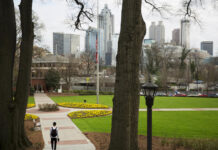April 29, 2017
On a sweltering April day, tens of thousands of demonstrators assembled in Washington on Saturday for the latest installment of the regular protests that punctuate the Trump era.

April 29, 2017
On a sweltering April day, tens of thousands of demonstrators assembled in Washington on Saturday for the latest installment of the regular protests that punctuate the Trump era.

Demonstrators sit on the ground along Pennsylvania Ave. in front of the White House in Washington, Saturday, April 29, 2017, during a demonstration and march. Thousands of people gathered across the country to march in protest of President Donald Trump's environmental policies, which have included rolling back restrictions on mining, oil drilling and greenhouse gas emissions at coal-fired power plants. The demonstrators sat down for 100 seconds to mark President Trump's first 100 days in office. © Pablo Martinez Monsivais/AP Photo
This large-scale climate march marked President Trump’s first 100 days in office, which have already seen multiple rollbacks of environmental protections and Obama climate policies.
The Peoples Climate March, which originated with a massive demonstration in New York in September 2014, picked a symbolically striking day for its 2017 event. The temperature reached 91 degrees at D.C.’s National Airport at 2:59 p.m., tying a heat record for April 29 in the district set in 1974 — which only amplified the movement’s message.
On the eve of the march, the Environmental Protection Agency announced that it was beginning an overhaul of its website, which included taking down a long-standing site devoted to the science of climate change, which the agency said was “under review.”
“Hang on EPA, the midterms are coming. 2018,” read one sign carried by Kathy Sommer of Stony Brook, N.Y, as the protest assembled on the National Mall Saturday morning.
“There is no Planet B,” read another sign by Eva Gunther of Washington, D.C., displaying one of the most popular and oft repeated messages of the event (and of last week’s March for Science).
Hillary Clinton tweeted praise of the marchers Saturday afternoon, writing, “Great to see ppl take to the streets & combat climate change, protect the next generation & fight for jobs & economic justice.”
President Trump was in Pennsylvania for a rally on Saturday and did not tweet any immediate reaction.
Many of the signs at Saturday’s climate march were dark and ominous, warning of climate catastrophe, dying oceans, crop destruction and planet degradation. But the mood of the marchers was anything but somber. It was a racially diverse crowd with marchers of all ages. There were women with flowers in their hair. A man dressed in Uncle Sam overalls. There were little girls in strawberry sundresses and boys in baseball caps astride their fathers’ shoulders.
There were babies in strollers, like the boy who’d traveled with his family from Nashville and was now rolling down Pennsylvania Avenue carrying a sign that read, “Less pollution, more solutions.” There were elderly folks, too, such as 91-year-old Dorothy Peterson, who had traveled from Pittsburgh. She had a sun hat that resembled the earth and carried a sign in her wheelchair that read, “Mother Earth is older than me. Respect your elders.”
“It’s beautiful,” said Allison Dale, a geologist from Conshohocken, Pa. “it’s so well organized and everyone is really friendly and in a really good mood.”
The protest itself smelled of sweat and sunscreen and the occasional whiff of incense. It sounded like a drum circle – a never-ending drum circle – but not only that. The cacophony included banjos and boomboxes and at least one kazoo, tambourines and ukuleles and, yes, cowbell. Lots of cowbell. At one point, a full-on brass band – tubas, trombones, trumpets – waltzed by in full swing in front of the White House, while a man on stilts danced amid the musicians.
There were chants, of course:
“Shame, shame, shame!”
“Hey hey, ho ho, Scott Pruitt has got to go!”
“Resistance is here to stay, welcome to your 100th day.”
But none more ubiquitous than, “The oceans are rising and so are we!”
The climate event differs from last week’s March for Science in its focus and also its participants — only 1 out of 8 contingents of Saturday’s protest featured scientific researchers. The rest included labor activists, indigenous people already facing severe effects from climate change, and children and young people who will live with the effects of climate change longest as the Earth continues to warm.
But there was plenty of overlap between the marches. Ken Hunter, 78, traveled from Charlestown, W.Va. for the climate march and also came to Washington for the March for Science last weekend and the Tax March on April 15 — and attended a Women’s March in Florida.
“Hell, I haven’t marched this much in years,” Hunter said with a laugh. “But these are all very important issues and it was important to be out here.”
The motivation for the current climate march is clear: The Trump administration already has moved to roll back former president Barack Obama’s signature climate initiative, the Clean Power Plan, and Trump and his team have taken many other actions to weaken environmental protections of air and water, and to enable fossil fuel exploitation on public lands and waters.
The administration is grappling with a major climate policy decision: whether to remain in the Paris climate agreement. Several of Trump’s Cabinet picks are advising against following through on his campaign pledge to “cancel” the accord.

It all adds up to a big contrast with the original People’s Climate March in 2014. That event was aimed at rallying support for climate change action and preceded by about a year the Paris climate agreement. This year’s event was more focused on resisting rollbacks of climate efforts. Celebrity attendees included Leonardo DiCaprio, Al Gore and Richard Branson.
The focus on Trump was not necessarily intentional: In a press statement, Paul Getsos, national coordinator of the People’s Climate Movement, said the event was planned “before the election.”
For Ethan Fekete, Saturday’s climate march was the first protest he has taken part in.
“Ironically we march to get rid of our carbon footprint,” said the 13 year-old Virginia Beach resident who attended the march with his dad and a friend.
“It’s so much more than just a bunch of people walking around,” Fekete said. “The signs are so creative and everyone is here for a good cause.”
Some of the more creative signs observed on Saturday included the following: “Good planets are hard to find,” “Make Earth Great Again!” “May the forest be with you,” and “Reduce, Reuse, Recycle, Resist.”
Marchers on Saturday gathered at the Capitol and marched along Pennsylvania Avenue. They covered the entire width of the avenue and its length from the Capitol to 14th Street. The crowd filled Pennsylvania Avenue and the sidewalks carrying signs decrying the president and his actions on the environment.
The marchers unleashed their anger as they passed directly in front of the Trump hotel where they booed loudly and chanted “Shame!”and “We want a leader, not a creepy tweeter!” and “we will not go away, welcome to your 100 days!”
As the march streamed toward the White House, Freedom Plaza, an open area along Pennsylvania Avenue, provided an off-ramp for sweltering protesters. At the far end of the plaza a series of six large water tanks awaited. Activists lined up to refill their bottles and, in a few cases, douse their heads.
Just before 3 p.m., temperatures at Washington, D.C.’s National Airport hit 91 degrees but the heat index was even higher at 95.
Shortly before 4 p.m., the D.C. Homeland Security and Emergency Management Agency issued a hyperthermia alert, citing a heat index of 96 degrees. Residents without air-conditioning were told they could go to city recreation facilities, senior centers or other air-conditioned city buildings.
D.C. Fire and EMS received more than 50 calls for medical assistance at the march, with the “great majority” being heat-related, said Vito Maggiolo, a spokesman for the D.C. Fire and EMS department. Four people were transported to local hospitals, though Maggiolo said he did not know their condition.
The protesters were vociferous but peaceful. Interactions with the phalanx of police officers who stood at barriers in front of the hotel were friendly, with many protesters stopping to get pictures of themselves with officers.
They planned to “surround” the White House, according to the march website, and “make a loud sound demanding climate justice and good jobs that will drown out all of the climate-denying nonsense that has been coming out of this Administration.”
At 15th Street, where the march began to turn north to begin the loop around the White House, the movement encountered a pro-life protester with a bullhorn. “Abortion is destroying human life,” he said.
The protesters sat on the concrete and began clapping as they steadily chanted, “My body, my choice.”
On the western side of the White House near the Old Executive Office Building, the march changed character as it completed a loop around the center of U.S. presidential power. Instead of being densely packed and full of energy, the protesters grew more widely spaced out and slower in their strides. Some took a detour behind the White House and paused to sit in the shade on the grass between the South Lawn and the Ellipse.
In the middle of Lafayette Square, where the tired and sunburned masses of demonstrators huddled under the shade of trees to picnic and relax, a man with a bullhorn reminded them to take all their trash with them, to leave the place cleaner than they had found it. He needn’t have bothered. The recycling cans already were filling up. Many protestors had brought extra plastic bags, to cart away any extra trash.
“I’ll be fine in my lifetime. But what they experience and what their children experience could be catastrophic,” said Hamid Doumbia, 39, who had come downtown from Rockville with his two children, 4-year-old Jasmine and 8-year-old Noah, in tow. They’d made T-shirts for the march. “I wanted them to understand … I wanted to show them that it’s not just us, that a lot of people care about the world.”
By late afternoon, even has thousands of marchers worked their way from the White House to the Washington Monument, many demonstrators were calling it a day. They trickled back into the streets of downtown, lugging their signs as they descended into the Metro or boarded buses for long trips home.
The line grew long outside the FroZenYo around the corner from the White House, where the climate warriors were looking for a way to cool off.
Organizers told the National Park Service that they expect 50,000 to 100,000 attendees. By late afternoon, they were claiming to have greatly exceeded that and reached 200,000. More than 375 satellite marches were held around the United States and even more around the world, from Manila to Amsterdam.
Getting to the march proved frustrating for many who chose to use public transportation. Metro officials did not make changes to their planned maintenance schedule, which affected several downtown stations that would normally be used by riders headed to the National Mall. In some instances, shuttle buses replaced trains. Many marchers complained the service was slow and were confused about where to board shuttle buses.
Courtesy: Washington Post











































































































